► The most luxury cars with EV power
► From Mercedes to Ferrari
► We’ll keep updating this list
The best hybrid cars really do get everywhere these days. Gone are the days of electrified powertrains only finding favour with super-economical hatchbacks or niche manufacturers, luxury hybrid cars getting more popular every year.
It’s not like you’re limited to low-output four-pots, either. Hybrid luxury cars come in a range of different flavours from barely there mild-hybrid systems, Toyota Prius-style full or ‘self-charging’ hybrids and long-range plug-in hybrids.
The best hybrid luxury cars 2023
So, now you know what they are, but which one should you buy? We’ve rounded up ten of the best hybrid luxury cars in a range of bodystyles. If you’re more interested in hybrid SUVs, electrified estates or something a little more affordable, we’ve got your back, too.
Mercedes S580e L
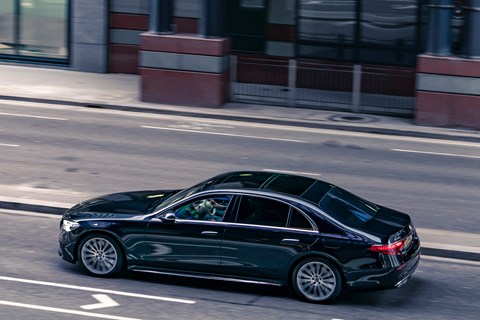
You’ve been able to buy a plug-in Sonderklasse for a few years now, but the current generation has taken a sizeable step forward. Combining a powerful yet smooth six-cylinder engine with a powerful electric motor boosts performance, and it has a truly massive battery to help everything along.
With a claimed 65 mile electric only range it’ll go further than almost any other PHEV, and it’s quick to charge, too. While most plug-ins take hours to top up, DC charging means it takes just 20 minutes to get from 10-80%. It certainly betters the Audi A8 TFSIe, although we’re looking forward to getting our hands on the plug-in BMW 7 Series.
Read our Mercedes S-class review
BMW X5 50e
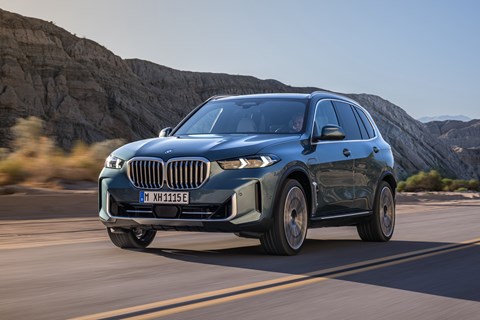
We’re big fans of the BMW X5 45e, but a 2023 facelift has increased both power and electric range enough for a new name, the X5 50e. Although the cake tastes slightly different this time around, the ingredients are much the same, with a turbocharged straight-six petrol engine doing the duties when you’re not running on volts.
It’s a combination that we put above the gruffer Mercedes GLE 350de, although that car does have much better fuel economy thanks to its smaller diesel engine. However, the X5 is plusher inside, better to drive and still usefully practical. Those that want seven seats will need to look elsewhere, though.
Read for more on the BMW X5
Bentley Flying Spur Hybrid

Yes, even Bentley are getting in on the hybrid game. Although a Bentayga Hybrid is available, it feels a little weak for a modern Bentley and can’t even manage 30 miles of electric only running. Thankfully the Flying Spur Hybrid doesn’t use an Audi-derived PHEV system that’s also found in the Volkswagen Touareg of all things.
Instead, you get a similarly sized but far more potent twin-turbo V6 that’s also found in the nose of the Porsche Panamera. The electric range still isn’t amazing, but it goes like a proper Bentley and feels more like one should inside.
Read our Bentley Flying Spur Hybrid review
Mercedes-AMG GLE 63 S
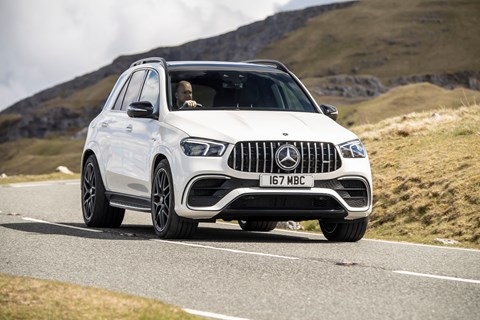
Unlike the AMG E63 S, the 4.0-litre twin-turbo V8 in the GLE 63S gets a mild hybrid boost to help improve efficiency and performance. The improvements are indeed as mild as the name suggests, with CO2 figures that’d get you on the wrong side of Greta Thunburg.
Similarly, the performance improvements are as slim as you’d expect from an electric motor with around 20bhp. Still, with over 600bhp from the engine, it’s not like the GLE needed a great deal of help here. Rivals include the more engaging but less comfortable BMW X5 M, while the bonkers Porsche Cayenne Turbo S E-Hybrid is faster still and even more efficient, if far pricier and less engaging than lesser Cayennes.
Read our Mercedes-AMG GLE review
Lexus LC500h
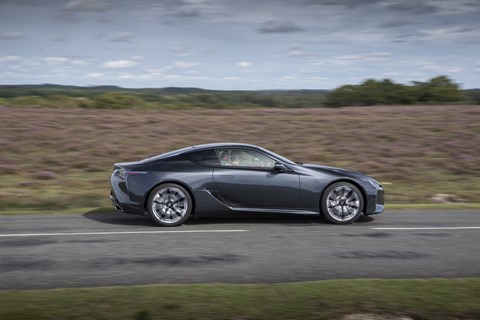
Yes, the 5.0-litre V8 is quicker and sounds fantastic, but your bank balance will prefer the more frugal LC500h. Sadly only available as a coupe, it combines a 3.5-litre V6 engine with an electric motor, compact battery and a gearbox so complicated, we simply don’t have the space to explain it in this article.
The result? 354bhp, potentially over 30mpg and CO2 figures that are far easier to swallow than the glamourpuss looks suggest. Just bear in mind that the Porsche 911 will be receiving some electrification in 2023, and we wouldn’t bet against it being even more fun.
Read our Lexus LC500h review
Volvo XC90 Recharge
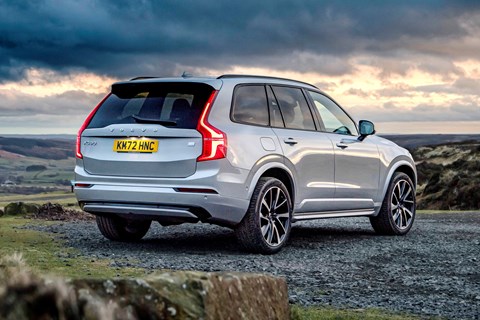
Although there are many SUVs that are available with seven seats or PHEV power, there are shockingly few that combine both. If a Hyundai Santa Fe or Kia Sorento just isn’t posh enough for you, then we’d point you towards the Volvo XC90.
Yes, it’s been around a while and yes, there’s an all-electric Volvo EX90 coming, but the XC90 Recharge is still as relevant as ever. A 2022 battery upgrade greatly improved the range and BIK rating, while the interior is still an oasis of calm with a third row some adults will even fit in.
Read our Volvo XC90 Recharge review
Porsche Panamera S E-Hybrid

Think of this as a cheaper, racier Flying Spur Hybrid and you won’t be a million miles off. Both share a hybrid system and platform, with the Panamera forgoing a bit of luxury and comfort for performance and handling.
We’d stick to the S E-Hybrid rather than the ridiculously powerful Turbo S E-Hybrid as it’s nimbler and plenty fast enough. Besides, if you want a truly unhinged PHEV five-door coupe, the Mercedes-AMG GT 63 S E-Performance has over 800bhp, where the Porsche can’t even hit 700bhp. What a time to be alive.
Read our Porsche Panamera hybrid review
Lexus NX

Although the pricier and posher Lexus RX exists, it’s the smaller NX that’s the better car. Available with full and plug-in hybrid powertrains, it utilises the same 2.5-litre four-cylinder engine for both. Shared with the Toyota RAV4 PHEV, its slightly gruff edge sits more comfortably in this class than the one above.
That’s one of our few complaints, though. Interior quality impresses, it’s practical enough while the PHEV has a much longer electric range than the BMW X3 30e, and drives better than the Mercedes GLC 300e.
Read our Lexus NX review
Range Rover
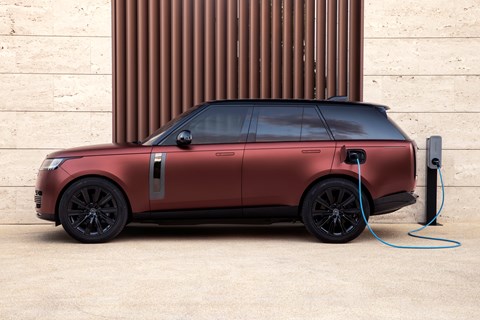
Whether you pick the full-sized Rangey or the smaller Range Rover Sport, the mild and plug-in hybrid engines are very impressive. Arguably the one to go for is the mild-hybrid D350 diesel, a powerplant that’s delightfully smooth, capable of in excess of 35mpg and much cheaper than the P440e PHEV.
Not that the PHEV isn’t deeply impressive. With a class leading electric only range and standard DC rapid charging capabilities, you can rarely bother the straight-six petrol engine under the bonnet. Regardless of engine, it’ll go places where few others can. If you need more ability from your hybrid, you’ll be looking at the Land Rover Defender.
Read our Range Rover review
Ferrari 296 GTB
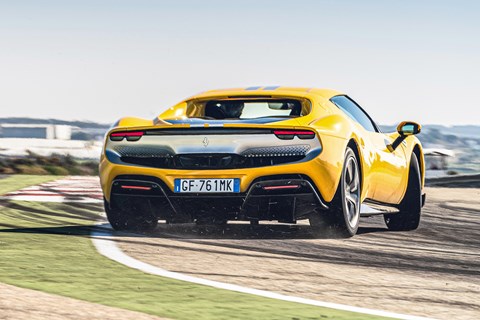
Have we saved the best until last? Quite possibly, as the 296 GTB proves a plug-in hybrid can still deliver a thrilling driving experience in the bends as well as a straight line. Combining a turbocharged V6 with a chunky electric motor gives 819bhp and a sub-3.0 second 0-62mph time.
It’s not the only PHEV supercar, either. Ignoring limited-run hypercars like the McLaren P1 and Porsche 918, there’s also the McLaren Artura which follows a similar path to performance as the 296.
Read our Ferrari 296 GTB review
What are the differences?
When looking at a luxury hybrid car, it’s best to work out what you want from it. If you’re a company car user, a plug-in (PHEV) can massively reduce your BIK bills, in some cases to well below far cheaper conventional cars. Many, such as the Mercedes S580e are now also able to run for long distances on electric, potentially offering cheaper fuel bills, too.
If you’re unable to plug in or are buying privately, a full or mild hybrid may be a better bet. A full hybrid such as that available in the Lexus NX and RX SUVs is usually a cheaper option than a PHEV. Even so, it’s still able to give a hearty economy uplift thanks to its ability to store otherwise wasted energy to use later. This is why they’re also known as self-charging hybrids.
A mild hybrid is a surprisingly Ronseal term. Instead of having a big electric motor and moderately sized motor that’s able to power the car for a mile or two, they generally have a much smaller motor that’s used to start the engine smoothly and give a little power boost to help performance and efficiency. Many BMW engines now come with this feature, while Mercedes motors with EQ Boost are as well.
We’ve also produced a guide on the pros and cons of hybrid cars, if you’re still not sure which powertrain to choose in 2023.
Which luxury cars have hybrid models?
Luxury cars may exist in their own rarefied atmosphere when it comes to price and exclusivity, but they can’t escape the march to electrification. That means more luxury cars are moving towards hybrid power, or even electric power. Just a few years ago the list above would be impossible to make, but as emission laws continue to strangle the V12s and V10s traditionally found in luxury cars, the more sophsiticated hybrid barges we’re going to get.